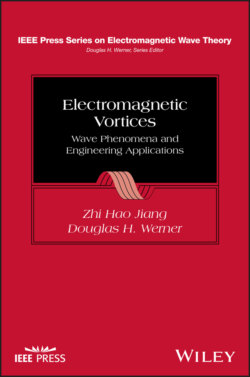Читать книгу Electromagnetic Vortices - Группа авторов - Страница 16
1.1 Electromagnetic Fields Carry Orbital Angular Momentum
ОглавлениеAngular momentum is the rotational equivalent of linear momentum. An object moving in a straight line carries linear momentum. Along with its linear motion, an object can also rotate in two distinct ways. A spinning object carries spin angular momentum (SAM) and an orbiting object carries orbital angular momentum (OAM), with Earth being an interesting example for consideration. The analogy between the angular momentum of a moving object and the electromagnetic wave’s angular momentum is shown in Figure 1.1. Earth’s spinning is associated with SAM; Earth’s orbital motion around the sun is linked to OAM. Electromagnetic beams may also carry these two types of momenta. If the electric field vector rotates along the beam axis, the beam has SAM; if the electromagnetic field’s wavefront is twisting, with the wave vector forming a helix, the beam has OAM.
The history of angular momentum dates back to the early twentieth century. The SAM of light was theoretically studied for the first time by Poynting in 1909 [1] and experimentally studied by Beth in 1936 [2]. SAM is intrinsic, since it does not depend on the choice of an axis, and it is only polarization dependent. If s is the SAM mode number, then s = ±1 corresponds to right‐ and left‐hand polarized waves, and s = 0 corresponds to linearly polarized waves. Although the experimental demonstration of the exchange of angular momentum between circularly polarized beams and matter was performed more than 80 years ago, the work associated with light’s angular momentum has been almost exclusively concerned with SAM.
It was not until 1992 that Allen et al. [3] showed that helically phased beams with a phase term ejlϕ (where is the imaginary unit, l is the OAM mode number, and ϕ is the azimuthal angle) carry OAM. The wavefront of an OAM beam is a spiral; the phase twists around the beam axis and changes 2πl after a full turn. Unlike SAM, OAM is linked to spatial distribution rather than polarization. OAM is extrinsic, since it depends on the choice of the calculation axis. The angular momentum is the composition of SAM and OAM, such that the angular momentum mode number is j = s + l.
Figure 1.1 Analogy between moving object’s and electromagnetic wave’s angular momentum: (a) Earth spins and carries SAM; (b) Earth orbits around the sun and carries OAM; (c) a circularly polarized wave carries SAM; the electric field vector rotates along a straight beam axis; (d) a circularly polarized OAM‐carrying wave carries both SAM and OAM; the electric field vector rotates along a spiral beam axis; (e) beam with planar wavefront; the wavevector is straight; (f) OAM‐carrying beams with spiral wavefront; the wavevector is twisted.
